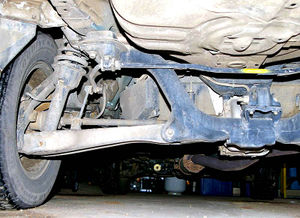Difference between revisions of "Independent suspension"
m |
m |
||
| Line 1: | Line 1: | ||
{{X}} | {{X}} | ||
[[Image:Independent rear suspension AWD.jpg|thumb|right|A [[MacPherson strut]] type rear independent suspension on an [[Four-wheel drive|AWD]] car. The anti-roll bar has some orange paint on it.]] | [[Image:Independent rear suspension AWD.jpg|thumb|right|A [[MacPherson strut]] type rear independent suspension on an [[Four-wheel drive|AWD]] car. The anti-roll bar has some orange paint on it.]] | ||
| + | |||
| + | |||
'''Independent suspension''' is a broad term for any [[automobile]] [[suspension (vehicle)|suspension]] system that allows each wheel on the same [[axle]] to move vertically (i.e. reacting to a bump in the road) independently of each other. This is contrasted with a [[beam axle]], [[live axle]] or [[deDion axle|deDion]] system in which the wheels are linked - movement on one side affects the wheel on the other side. Note that “independent” refers to the motion or path of movement of the wheels/suspension. It is common for the left and right sides of the suspension to be connected with anti-roll bars or other such mechanisms. The anti-roll bar ties the left and right suspension spring rates together but does not tie their motion together. | '''Independent suspension''' is a broad term for any [[automobile]] [[suspension (vehicle)|suspension]] system that allows each wheel on the same [[axle]] to move vertically (i.e. reacting to a bump in the road) independently of each other. This is contrasted with a [[beam axle]], [[live axle]] or [[deDion axle|deDion]] system in which the wheels are linked - movement on one side affects the wheel on the other side. Note that “independent” refers to the motion or path of movement of the wheels/suspension. It is common for the left and right sides of the suspension to be connected with anti-roll bars or other such mechanisms. The anti-roll bar ties the left and right suspension spring rates together but does not tie their motion together. | ||
Revision as of 07:15, 12 June 2009

Independent suspension is a broad term for any automobile suspension system that allows each wheel on the same axle to move vertically (i.e. reacting to a bump in the road) independently of each other. This is contrasted with a beam axle, live axle or deDion system in which the wheels are linked - movement on one side affects the wheel on the other side. Note that “independent” refers to the motion or path of movement of the wheels/suspension. It is common for the left and right sides of the suspension to be connected with anti-roll bars or other such mechanisms. The anti-roll bar ties the left and right suspension spring rates together but does not tie their motion together.
Most modern vehicles have independent front suspension (IFS). Many vehicles also have an independent rear suspension (IRS). IRS, as the name implies, has the rear wheels independently sprung. A fully independent suspension has an independent suspension on all wheels. Some early independent systems used swing axles, but modern systems use Chapman or MacPherson struts, trailing arms, multiple links, or wishbones.
Independent suspension typically offers better ride quality and handling characteristics, due to lower unsprung weight and the ability of each wheel to address the road undisturbed by activities of the other wheel on the vehicle. Independent suspension requires additional engineering effort and expense in development versus a live axle or beam axle arrangement. A very complex IRS solution can also result in higher manufacturing costs.
The key reason for lower unsprung weight relative to a live axle design is that, for driven wheels, the differential unit does not form part of the unsprung elements of the suspension system. Instead it is either bolted directly to the vehicle's chassis, or more commonly to a subframe.
The relative movement between the wheels and the differential is achieved through the use of swinging driveshafts connected via universal (U) joints, analogous to the constant-velocity (CV) joints used in front wheel drive vehicles.